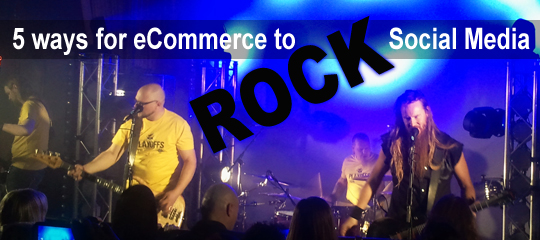Who uses social media to promote themselves? Chances are that names like Justin Bieber and Taylor Swift jump to mind. But eCommerce businesses can toot their horns very effectively on social media. Here are five strategies you can apply to your online store today.
1. Put On a Human Face
Online stores offer many advantages over brick and mortar stores, but they also have one big disadvantage. They are cold and distant. There is no live human. There is no social interaction. You can’t even touch the merchandise!
Enter social media. Social media platforms like Twitter, Instagram and Facebook give you a venue to interact with customers and passers-by.
Allow me to explain.
Without social media, your store is just another lean-to somewhere in Antarctica.
With social media, your store is at the corner of First and Main at lunchtime.
Here are eight tips to put a human face on your business in social media
- Don’t just broadcast news or specials. Social media is not a hit-and-run tool. Yes, it’s media, but it’s social media. Engage, don’t just broadcast.
- Respond to all comments and feedback publicly. Positive, negative and neutral, treat everyone with respect.
- Exception to #2 above: ignore <abbr title=”people looking for a fight or stalking you”>trolls</abbr>. Nobody ever won by engaging a troll. Ignore them in all ways possible.
- Another exception to #2 above: respond privately to people if your response could in any way be embarrassing to them or reveal information they might consider to be private. Still, respond publicly first, saying that you will contact them privately.
- Ask questions, prompting people to interact with you.
- Highlight employees in any way you can. Develop a plan for this.
- Highlight customers in any way you can. You can develop a plan for this, too. Don’t forget that your business is all about your customers.
- Use plain language. Leave the jargon behind. Here’s how to easily write plain language.
2. Be a Rifle
In most communications, you have the choice between being a rifle or being a shotgun. A rifle is used to hit a very specific target. It’s like a surgical strike. A shotgun is used to hit whatever happens to be around. It’s, well, messy.
I recommend using a rifle approach when targeting social media prospects. Define your audience and target them. If your store is selling something strictly of interest to Canadians, seek out Canadian followers.
If your store sells products specific to dogs, seek out dog owners to follow your social media accounts.
If you sell something organic, seek out people who express an interest in “organic”, “natural” and “green” issues.
3. Be a Shotgun
The rifle is amazing, but it’s a lot of work. The shotgun is messy, but it’s less work and…it can also be amazing. Let’s do the math. I’ve pulled the following numbers out of thin air; they are just for illustration.
Let’s suppose that you work really hard to get 5 new followers on Twitter. They are all Canadian. Or dog owners. Or fans of things organic. Yay – your target audience.
Now let’s suppose that the next day you pull in any followers you can get. You spend the same amount of time as the previous day, but you are rewarded with 100 new followers. Sure, that sounds impressive, but how many of those followers are actually part of your target market?
Well, 5 of them are probably Canadians. 10 of them are probably dog owners. And 15 of them are probably organic fans.
Again, let me stress that I am making up hypothetical numbers. The point is that for the same amount of work, the shotgun might yield even more potential buyers. Plus you have an extra 85 to 95 people following you.
What about those extra, non-targeted people?
They all know Canadians (or dog owners or organic fans). If they like what they see, they can refer people to you.
They all have followers in your niche. If they like your posts, they might share them with their followers – including those in your niche.
They all buy gifts, sometimes for people in your niche. So, 10 new followers might be dog owners, but another 10 might buy gifts for dog owners. And you would have missed them with the rifle.
There is a downside to the shotgun approach. You might find yourself having to interact with those extra 85 to 95 people, and that takes time. Chances are that you’ll interact most with people likely to buy, but that will vary by niche and by how you communicate.
So, which to use, the rifle or the shotgun? I am a big fan of using both, but here’s a good rule of thumb: the wider and more diverse your market, the more value you get from the shotgun. The more tightly defined your market is, the more valuable the rifle approach is.
4. Be 10% Better
There is a rule that says if you can improve everything by just 10 percent, you can improve your business by much more than 10 percent. The theory is that improving things by 10 percent is much easier than, say, doubling some aspect of your business.
Applying this rule to social media is much easier than setting your sight on skyrocketing one aspect. For instance, you could set these goals:
- Increase Twitter followers by 10 percent.
- Curate 10 percent more content to share with followers.
- Check for messages and mentions 10 percent more often, so as to respond quicker.
- Comment on and share your followers’ posts 10 percent more frequently.
If you have 10 percent more followers, each getting 10 percent more messages and 10 percent quicker responses, you should get more than 10 percent increase in sales (or at least visits) from social media.
There is nothing magical about the number 10. If even this seems too onerous, make it five percent. If you feel ambitious, make it 20 percent. Whatever number you choose, math is your friend.
5. Be Visual
This is my favorite tip, perhaps because it appeals to the hidden artist in me. Social media is a visual medium.
Consider these statistics:
- Four times as many people would prefer watching a video about your product than reading about it.
- Eye-tracking studies show that people look more at pictures than at text (except decorative pictures).
- The main takeaways from the just-released 2017 Social Media Marketing Report are almost all about visual content.
- Tweets with images get 18 percent more retweets and 89 percent more favorites.
- Photos on Facebook get 53 percent more likes and 104 percent more comments.
Of course, posting pics of your product won’t make much of a difference. That’s boring. Here are some alternatives:
Post images of people using your product. This helps people see that it is useful and perhaps also how it could help them.
Post images of the results of the product – the waffles made with your waffle iron or the new fence made with your hammer.
Post images of your product with a highly sharable message. For instance:
- Top 5 waffle recipes made with Acme Waffle Maker
- 5 ways the Acme Hammer has actually saved lives
These mini-posters grab people’s attention and they really do share them (unlike standard product shots).
Be creative. For instance, post pictures of your product in strange places. Or dress up your product with a wig and fake mustache and picture it cuddling with various kittens. Creative is good. It grabs attention. Creative is even better if you can subconsciously slip in a benefit or position your products.
Now, I’m not saying your eCommerce business has to have celebrity social media accounts, but take a look at Justin Bieber‘s and Taylor Swift’s Twitter feeds.
How many of the strategies above do you use?
[Main Image: Kotiteollisuus photo by Kris Olin; other images from their respective websites and/or social platforms]
David Leonhardt is a social media addict and a writer. He and his team can write your posts and promote them on social networks such as Google Plus, Twitter, LinkedIn, Pinterest, StumbleUpon, FaceBook and elsewhere.

